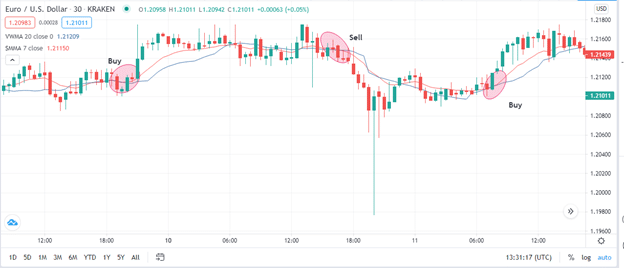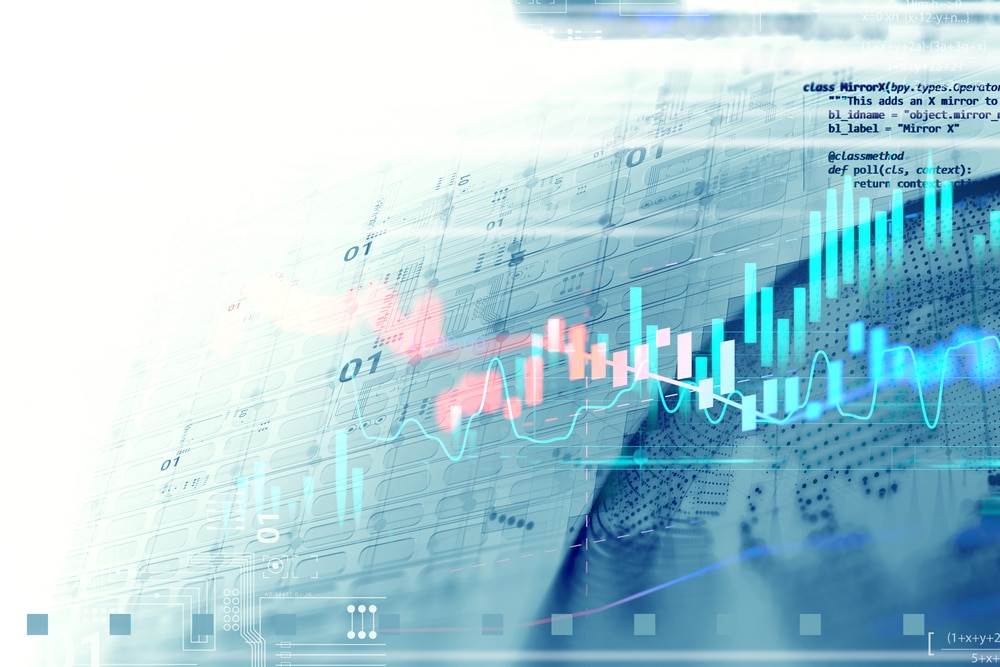Volume weighted average price (VWAP) refers to the average price at which an asset is traded in a market as evaluated by the corresponding volume. It is used as an indicator for confirming trends and helps traders to plot when to enter and exit trades.
The use of VWAP is based on the principle that trading volume is as important as the price in determining the trajectory of trade. Ultimately, the correlation between the price of an asset and the corresponding volume traded has a great impact on the psychology and behavior of traders.
How to calculate VWAP
We calculate VWAP by taking the asset prices at different times, multiplying them by the corresponding volume, and dividing the outcome by the total volume.
In essence, VWAP helps us to get the average price at which a stock is traded and how much of the stock was traded at that particular price.
The time window adapted is typically one day, but this is used to extrapolate the likely trading behavior for subsequent trading sessions.
VWAP = ∑ (Typical Price x Volume ) / ∑ Volume,
where Typical Price = Daily High + Daily Low + Closing Price / 3
VWAP is commonly used by traders when they want to hold long positions. In doing this, the prevailing market conditions are used as the foundation upon which trading calls are made.
Using VWAP as a moving average, traders can make calls based on whether the price is above the line or below it. Price movement above the line is taken as a buy signal. When the price moves below the VWAP, traders know it’s time to sell.
Based on the functions above, price action above the line signals a bullish run, while a movement below the line is read as a bearish signal. This makes this tool an asset in understanding market trends.
The VWAP pullback trading strategy
Some traders combine VWAP with moving averages to determine when to buy and sell. For example, when used together with a 7-period moving average, the former will be slower. Traders will buy when the price goes above VWAP and sell when it crosses the VWAP from above to below, as shown in the EUR/USD chart below.

Alternatively, you can use candlesticks to guide you on when to enter and exit. When the price movement moves away from the VWAP followed by a movement back towards the line, the entry point is the point closest to the volume line.
Using this logic, it follows that you should place the stop order at the point above the line.
VWAP vs. SMA
Simple moving average (SMA) and VWAP are correlated. Both help us understand the reasons behind the prevailing market prices based on a broader view of recent trading behavior.
The difference between them is that VWAP incorporates the impact of traded volume on price action, which is not the case with SMA.
SMA does not tell us the extent to which the prevailing prices influence the difference in trading volume. SMA works on the assumption that the volume of trade remains unchanged for each day under review.
Using VWAP to establish support and resistance levels
VWAP can also help us know the most appropriate levels to place support and resistance levels. This is done by looking at the current price relative to the average price during the timeframe under review.
If we spot the current price above the average price, the resistance level should be placed at the first point above the line.
If the price trend line is below VWAP, the closest point below the line becomes the support level.
A balanced trend is indicated when the two lines (VWAP and current price) are close to each other.
For a bearish trend or bullish trend, the VWAP should indicate a clear downward or upward trend. Support and resistance levels are more accurately plotted during these trends, as opposed to balanced trends.
VWAP for trade execution
VWAP is a helpful tool for stealthily making large purchases. When institutions want to buy or sell stock in large quantities, VWAP is a reliable tool to use when they want to avoid causing a sudden spike in traded volume. This is an essential aspect of bulk trading because such rises in volume can trigger market actions leading to an upsurge in prices.
To avoid this, large institutional buyers usually mask their purchases by breaking the large volume of shares into several smaller orders.
Through automation of orders, large buy orders can be placed to keep the actions of the big firms under the radar of most sellers.
By using smaller orders of stock, the prices will be kept near the VWAP. Consequently, the market will not be alerted about a sudden spike in demand for the stock, thereby reducing the probability of sellers raising the buying price.
Bottom line
VWAP is a vital strategy in trading because of its ability to synchronize the relationship between price and volume of stocks traded.
It can also be used to mitigate price hikes when placing large orders. However, its efficiency is subject to knowing how to calculate it and appreciating that it has some limitations, such as being unreliable for bearish or bullish signals when the trend is flat.
It should therefore be used alongside other indicators such as simple moving averages. At the same time, traders should pay close attention to market fundamentals.
